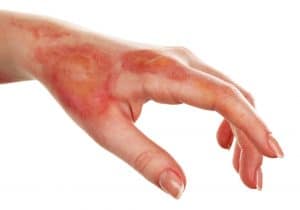Getting burned chemically can happen intentionally or accidentally. It can happen inside your home, while you’re at work, when you’re at school, or even when you’re on the road. Although only a few people die due to exposure with different chemicals, there are a lot of substances that are used on a daily basis that are proved to be harmful. You don’t want to be on the receiving end of it, as it can be painful and would often lead to irreversible injuries. This is why it’s vital that you’re prepared and know what to do immediately when you have a chemical burn.
What Is A Chemical Burn?
 A chemical burn is when your eyes, mouth, nose, or any part of your body gets in contact with a harmful chemical substance and becomes damaged. You may encounter this either through direct contact with the hazardous substance or when you get in contact with the fumes coming from it. You can get chemically burned by either an industrial or household chemical, both of which can cause you severe burns.
A chemical burn is when your eyes, mouth, nose, or any part of your body gets in contact with a harmful chemical substance and becomes damaged. You may encounter this either through direct contact with the hazardous substance or when you get in contact with the fumes coming from it. You can get chemically burned by either an industrial or household chemical, both of which can cause you severe burns.
A chemical can continuously injure you after you first get in touch with it. It might even cause you internal issues, especially if it’s not immediately correctly treated.
What Are The Chemicals That Cause Burns?
A lot of chemicals that can cause you burns are either base or acid. To help you better, read the labels of the chemicals you work with or handle. If you take time to make the necessary precaution and educate yourself, you can quickly decrease your chances of getting injured. Some chemicals that are toxic and can cause chemical burn are:
- Concrete mix
- Toilet or drain cleaners
- Metal cleaners
- Bleach
What To Do Immediately When You Get Chemically Burned?
1.) You should take time to learn about the different types of chemical burns.
a.) You should learn about the different kinds of chemical burns.
There are two kinds of chemical burns, alkali burns and acidic burns.
- Alkali burns are burns that are caused by fertilizer solutions, ammonia, batteries, pipe cleaners, and drain cleaners.
- Acidic burns are burns that are caused by acids such as sulfuric and hydrochloric. Despite their notorious reputation, they are far less toxic than alkali.
b.) You should learn to recognize a second-degree burn.
There are two kinds of burns that are second degree.
- A superficial burn is often identified by its color: red. It usually damages the topmost layer of your skin as well as your skin’s second layer. You’ll have blisters and will feel pain. The good news is that after a couple of weeks, it may heal without scars.
- Deep second-degree burns destroy your skin’s underlayer. It will appear white, which means that your blood vessels are damaged and is damaging your blood’s circulation.
c.) You should take time to understand and know a third-degree burn.
A third-degree burn is the burn that’s the worst and would mostly cause lasting damage. It affects your skin’s upper and lower layers; however, it extends through your subcutaneous tissue. This burn would cause your skin to feel and look like leather.
2.) You should immediately treat the chemical burn.
a.) You should immediately remove yourself or the patient from the scene of exposure.
After the incident, the chemical can still be dangerous to you or the victim. This is why you should make sure you or your patient be immediately removed.
- If you don’t remove yourself or the victim from the area, you risk the danger of getting splashed with more chemicals or being exposed to more fumes.
- If you’re usually handling chemicals, be sure to protect yourself by wearing personal protective equipment (PPE).
- If you see any dry chemicals on you or the victim’s skin, you should brush the substances off before you start washing it.
b.) You should remove any jewelry or clothing on and around the area of the burn.
If you or the victim have any items that are in the area of the burn or around it, be sure that it’s removed as soon as possible. These items can cause more damage and prevent access from the site of the burn.
c.) You should wash the burn rigorously.
If you or someone else has received a burn from chemicals, you should immediately dilute the chemical.
 You should flush the burn with water and the area around it.
You should flush the burn with water and the area around it.- Make sure to use enough pressure of water.
- The water you use should have a cool temperature.
- You should let the water run over you or the victim’s burn for at least 10 minutes.
- There are chemicals that when in contact with the skin they should be washed with water. Make sure the burn can be cleaned with water.
d.) You should apply a dressing that’s sterile and clean on the burn.
After you’ve cleaned the wound, make sure you cover it with a dressing that’s clean and sterile. The dressing can help you protect the wound from getting an infection from bacteria or further damage from chemicals.
3.) You should immediately seek medical help.
If you or anyone you know suffers from a chemical burn, it’s vital that you seek help from medical professionals. You can also get in touch with the poison control center. First aid can help you; however, professional help is better.
Also, if you’re looking to file a lawsuit because of your burn, a medical report is helpful in proving your case.
Get Legal Help
If you’ve been attacked by another person with acid, or have experienced chemical burn while at work, be sure to get in touch with a lawyer immediately. The lawyer will be able to help you make the necessary legal steps when dealing with chemical burn cases.
If you’re looking for a reliable lawyer after you’ve been burned with chemicals, click here. They may be able to help you go through the legal process and achieve a resolution. Good Luck!

Ashley Thompson
Ashley Thompson is a promising young law writer. She hopes to apply her years of study into helping explain legal issues to the public. Ashley loves cooking and often cooks for her family during weekends.

